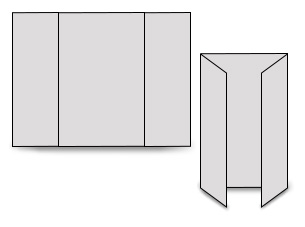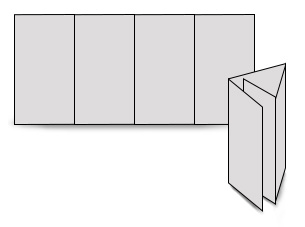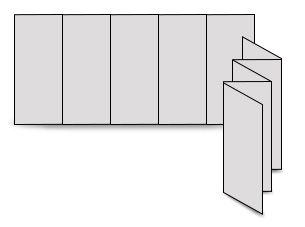To Have and To Fold

We don’t know if you’ve ever witnessed The Great Escape. But it’s a fairly common occurrence in our business (creative services, that is): Here’s how it typically plays out:
Client: I need a trifold.
Designer: AAAAARRRRRGGGGHHHHH!!!!!!
Client: Where did he go?
Account Person: Probably to a bar.
Client: Why?
Account Person: Because he has no idea what you mean by that.
The challenge is that most people who ask for a trifold mean a brochure that has two folds. That’s confusing enough. But many people who ask for a trifold are imagining the finished piece to be a specific size. And for some reason, they never seem particularly inclined to share that information.
The Usual
Most frequently, they’re referring to a single gate fold. (See the diagram to the right.) If they’re presuming it’s a simple 8.5″ x 11″ sheet of paper, held in landscape orientation and folded twice, they may also refer to it as a flyer and leave it to the designer to diving their meaning. If they mean a larger piece, regardless of the dimensions, they’re likely to refer to it as a brochure and leave it to the designer to guess the rest. And they’re not likely to supply the crystal ball or the Ouija Board.
Any or all of these vagaries may explain why designers are prone to migraines, bouts of depression, fits of rage, compulsive binge drinking, and or thoughts of suicide. But all of those maladies can be mitigated, if not eliminated entirely, with a little conscientious clarity from the client.
Try These
Here’s a handy guide to common folds. Using it will ensure you’re doing your part to keeping your designer sane:


- The most common alternative to the single gate fold is the double gate fold. Perhaps the most intuitively simple of all the folds (see the diagram to the left), this design is favored by clients who could have gotten away quite nicely with a single gate fold but couldn’t bear the thought of cutting out all of the fluff, jargon, buzzwords, and aimless palaver with which they were compelled to pack their copy. It also tends to be selected by clients who think the message they couldn’t write succinctly will be effectively conveyed by the charts, diagrams, stock photography, and info graphics with which they insist on packing their double gate folds.
- The next common fold is the Z fold (see the diagram to the right). This fold is the hands-down favorite of two types of people: (1) Practical jokers. These folks love to watch their marks fold, unfold, turn over, mull over, and otherwise work themselves into lathers trying to figure out the order in which the content of the Z-fold document should be read. (2) Writers who can’t write coherent copy with logical transitions to connect ideas. Those writer typically excuse their poor writing skills by saying things like, “It’s not intended to be read linearly.” (Translation: “I couldn’t understand it, either.”) And they have an uncanny knack for finding designers who also don’t care for (or can’t comprehend) linear thinking.


- The last common fold in this post is the accordion fold. As the diagram to the left suggests, this particular configuration of folds and panels was created to mimic the folds (gyri and sulci) found in brain tissue. The rationale neurologists have adopted to explain the folds in brain tissue is that more folds equal more surface area. More surface area, they hypothesized, must equal greater areas of space to be occupied by neurons. Therefore, more neurons, theoretically speaking, should equal more thinking power. But as Albert Einstein pointed out, “In theory, theory and practice are the same. In practice, they’re different.” As it turns out, whether the theoretical thinking ever manifested in actual cognitive practice is immaterial because the only person who ever favored the accordion fold was Myron Floren.
For Better, For Worse
So, for the sake of graphic designers everywhere, hire good writers. Give them the latitude to work with competent graphic designers. Don’t tell the writers or the graphic designers what to do. And be prepared to be amazed by the great results.
Follow this advice and you and your target audience will take each other, to have and to fold, from this day forward, forever and ever.
Amen.
This content is available for syndication. Please contact us for details.

Send me your mailing address and I’ll send you a folding dummy for the “Baraff fold.”
Wow, this post has given me useful info and answered some of my questions. I hope to give something back and aid others like you helped me. Feel free to surf my website ZH5 about Thai-Massage.